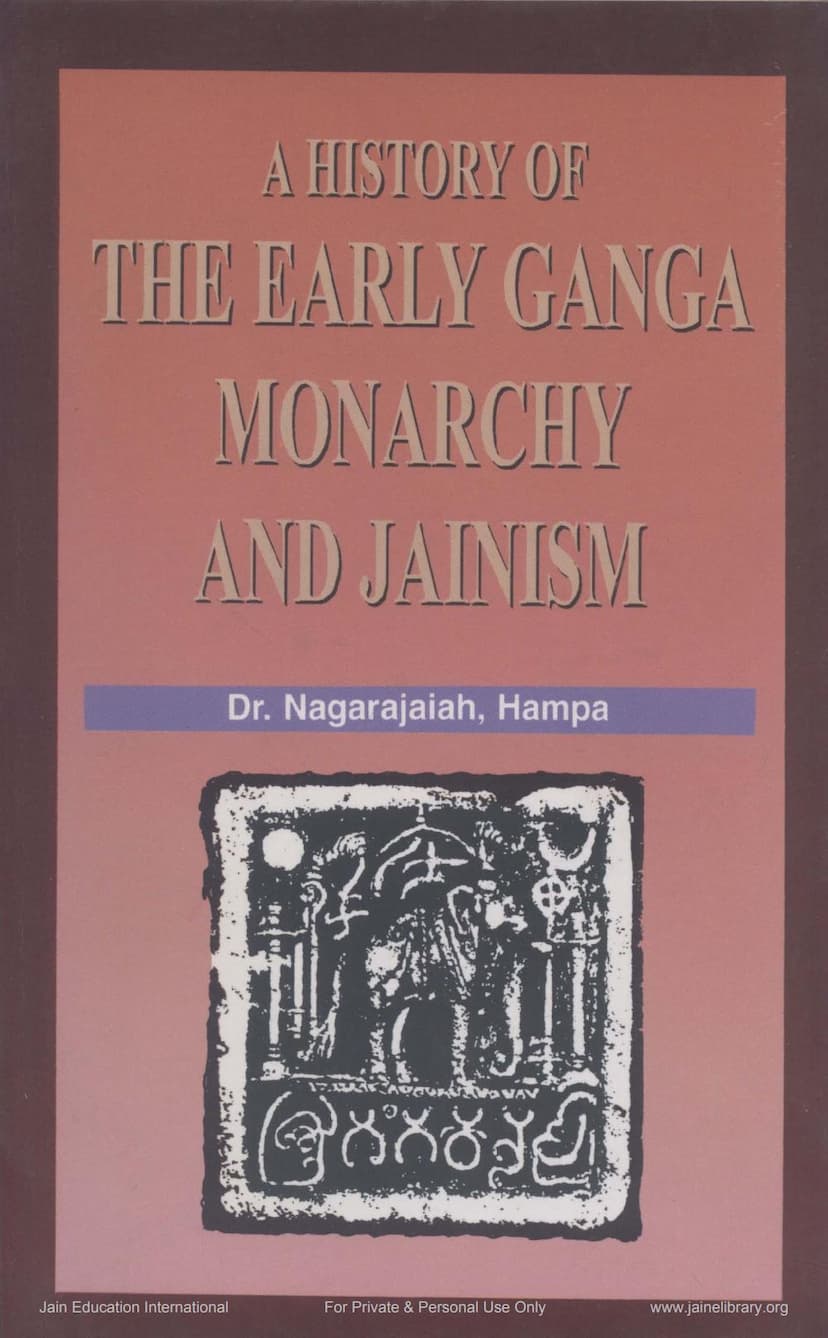History Of Early Ganga Monarchy And Jainism
Added to library: September 1, 2025

Summary
This summary is based on the provided text for "A History of the Early Ganga Monarchy and Jainism" by Dr. Nagarajaiah Hampa.
Overall Scope and Purpose:
The book "A History of the Early Ganga Monarchy and Jainism" by Dr. Nagarajaiah Hampa, published in 1999, is a monograph that delves into the significant and enduring relationship between the Early Western Ganga dynasty and the Jain religion. The author's primary aim is to demonstrate the deep and pervasive influence of Jainism on the Ganga rulers and their kingdom, primarily through extensive analysis of inscriptional evidence. The book focuses specifically on the early Ganga period, with a companion volume intended to cover the later Gangas.
Key Themes and Arguments:
-
Origin and Foundation: The book highlights the foundational role of the Jaina sage Simhanandi in the establishment of the Ganga dynasty. He is presented as the "kingmaker" who guided and empowered the founders, Dadiga and Madhava, and instilled in them a devotion to Jainism. This origin story underscores the natural inclination of the Gangas to support the creed that played such a pivotal role in their rise to power.
-
Royal Patronage and Devotion: A central thesis is that the Ganga kings, from their inception, were staunch supporters of Jainism. This patronage manifested in several ways:
- Consecration of Jaina images: The kings commissioned and sponsored the creation of numerous Jina images for worship.
- Temple construction and maintenance: The Gangas were prolific builders of basadis (Jaina temples) and actively ensured their upkeep and renovation. This included constructing temples from wood, brick, and stone, reflecting evolving architectural practices.
- Liberal grants and endowments: Significant land grants, villages, gardens, and financial support were consistently provided to Jaina shrines, monks, and monasteries.
- Support for Jaina scholars and monks: The royal patronage extended to the intellectual and spiritual leaders of Jainism, ensuring the flourishing of Jaina scholarship and monastic life.
- Personal devotion and practice: The book details instances of Ganga royalty, including kings and queens, embracing Jaina practices, undertaking pilgrimage, and even dedicating their lives to asceticism or dying by the rite of sallekhana (voluntary religious death).
-
Jainism as a Dominant Force: The monograph argues that under the Gangas, Jainism became a dominant creed in Karnataka. This is evident in the widespread presence of Jaina religious centers, the prominence of Jaina literature and philosophy, and the cultural integration of Jaina principles into the fabric of society.
-
Simhanandi as the Guiding Force: The pivotal role of Simhanandi is repeatedly emphasized. He not only facilitated the dynasty's rise but also laid down a Jaina code of conduct for the rulers, which they largely adhered to. The author discusses Simhanandi's movement and influence, noting his affiliation with the Yapaniya sangha and its eventual integration with the Mula sangha.
-
Ganga Kings and their Contributions: The book systematically outlines the contributions of various Ganga rulers, starting with the founders and moving through successive generations. Notable figures discussed include:
- Konganivarma Madhava I: Initiated temple building.
- Avinita: Paved the way for increased influence of Jainism.
- Durvinita: A significant benefactor, known for temple construction and literary contributions.
- Sivamara II: Embraced Jainism and actively promoted its development, making it a state religion.
- Racamalla I and II: Extended patronage to Tamil Nadu and continued to support Jaina establishments.
- Butuga II: A devout sravaka (lay votary) and his family's extensive support.
- Marasimha II: A great warrior and devout Jain, who also died by sallekhana.
- Camundaraya: A prominent minister and warrior, renowned for commissioning the Gommatesvara statue and the Camundaraya Basadi, and for his literary works.
-
Jaina Art and Architecture: The book references and illustrates various examples of Jaina art and architecture, including sculptures of Tirthankaras, Yakshas, Yakshis, magnificent pillars (manastambhas), intricate temple carvings, and large monolithic colossi like Gommatesvara. The illustrations in the book (as indicated by the page numbers with image references) highlight the artistic achievements of the Ganga period in service of Jainism.
-
Sustained Influence and Legacy: The Gangas' patronage of Jainism extended for approximately eight centuries. Their support for the religion influenced subsequent dynasties, including the Chalukyas, Rashtrakutas, and Hoyasalas, in their own patronage of Jainism. The author emphasizes that the Gangas bequeathed a rich legacy of Jaina art, architecture, and literature.
-
The Concept of Sallekhana: The practice of sallekhana, or voluntary religious death through fasting, is highlighted as a significant aspect of Ganga devotion to Jainism, with several royal family members choosing this path.
-
Challenges and Decline: While the book focuses on the golden age of Jainism under the Gangas, it also touches upon the later challenges and the eventual decline of Jainism's prominence due to socio-political shifts and the rise of other religious influences.
In essence, "A History of the Early Ganga Monarchy and Jainism" meticulously chronicles how the Ganga dynasty, from its inception, was deeply intertwined with and profoundly shaped by Jainism, making it a cornerstone of their rule, culture, and identity.